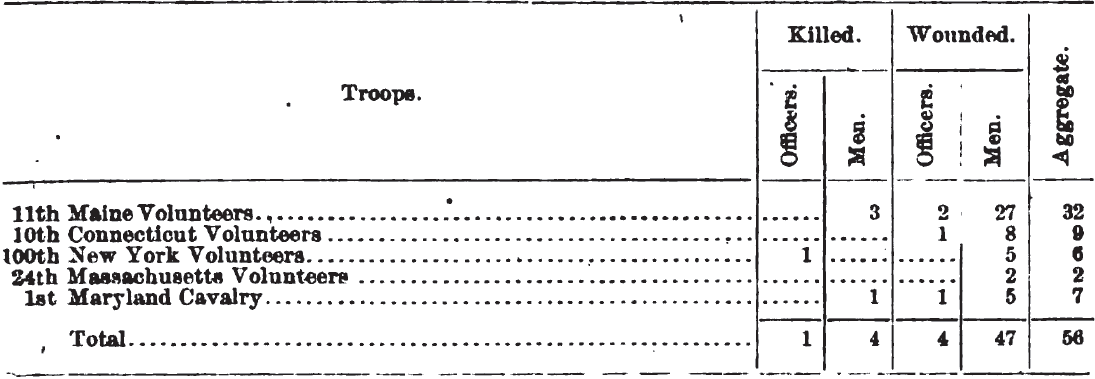Numbers 255. Reports of Brigadier General Robert S. Foster, U. S. Army, commanding Third Brigade, of operations July 11-12 and 23-29.1
JULY 12, 1864.
The volunteer party of two officers and fifty men called for by General Butler last evening have just returned. They, in connection with part of a company (Third Pennsylvania Heavy Artillery), landed at Dutch Gap at 9 last night; crossed at 2.30 this morning to Cox’s Wharf, where they captured 1 officer and 12 men; burned a mill, shop, dwelling, and out-houses, capturing a quantity of small-arms, a galvanic battery, 2 boxes powder, and a torpedo. No casualties on our side. Please send copy to General Butler.
R. S. FOSTER,
Brigadier-General.
Lieutenant Colonel E. W. SMITH,
Assistant Adjutant-General.
[Indorsement.]
Forwarded to the lieutenant-general for his information.
B. F. BUTLER,
Major-General.
HEADQUARTERS U. S. FORCES,
Deep Bottom, July 24, 1864-9.05 a.m.
This morning at daylight the Eleventh Maine, acting under my orders, advanced and occupied the enemy’s battery on the New Market and Malvern Hill road, and now have a strong picket fifty yards beyond, I shall hold it, if possible. The regiment lost yesterday 2 killed and 6 wounded. They deserve great credit, having been continually engaged day and night for three days, and I deem the position they hold of great importance to this command.
Respectfully, yours,
R. S. FOSTER,
Brigadier-General.
Brigadier-General WEITZEL,
Chief of Staff, Dept. of Virginia and North Carolina.
HEADQUARTERS,
Deep Bottom [July] 24, 1864.
I have present for duty, equipped, officers and men; Third Brigade, First Division, Tenth Army Corps, 2,374; Third Brigade—-Division, Nineteenth Army Corps, 1,252; First Connecticut Light Battery, six guns, 119; two companies First New York Mounted Rifles, 115; total, 3,860.
R. S. FOSTER,
Brigadier-General.
Lieutenant Colonel E. W. SMITH,
Assistant Adjutant-General.
HEADQUARTERS SECOND DIVISION TENTH ARMY CORPS,
In the Field, Va., September 27, 1864.
GENERAL: In answer to your communication of September 21, this day received, I have the honor to submit the following report of the operations of the Third Brigade, First Division, Tenth Army Corps, on the 26th, 27th, 28th, and 29th of July last:
On the afternoon of July 26, pursuant to instructions received from headquarters Department of Virginia and North Carolina, I caused the bridges across James River above and below Four-Mile Creek to be muffled for the passing of troops, and sent two regiments (the Tenth Connecticut and Eleventh Maine Volunteers) below Four-Mile Creek with orders to push forward across Strawberry Plains, and, if possible, reach the New Market and Malvern Hill road and to hold their position, if possible. They reached a line running parallel with the road and about seventy-five yards distant, after heavy skirmishing, and found the enemy entrenched in strong force along the road with a battery of four guns in position. This line was held by them until the morning of the 27th, when the troops of the Second Corps advanced and captured the battery, the two regiments co-operating with the charging party on their left. At 10 a.m. the 27th, the Eleventh Maine was withdrawn to the upper side of Four-Mile Creek, the Tenth Connecticut remaining as garrison at the bridge-head.
At 12.15 p.m. July 27, I was notified of a forward movement of the Second Army Corps and directed to endeavor to attract the attention
of the enemy on my front, and in compliance advanced the One hundredth New York and Twenty-fourth Massachusetts Regiments as skirmishers, with the Eleventh Maine and one section of First Connecticut Light Battery in support, driving the enemy back onto their main works. The object of the advance being accomplished, I retired within my original line at dusk.
On the afternoon of the 29th I was again directed to co-operate with a movement of the Second Corps, and advanced a line of skirmishers of the First Maryland (dismounted) Cavalry and Twenty-fourth Massachusetts, their right resting on Four-Mile Creek, their left near the Grover house. Four pieces of artillery were placed in position on the right of the Grover house. The enemy were driven within their main line of rifle-pits, from which it was impossible to dislodge them with the small force at my command. After shelling the enemy’s works for nearly an hour, I withdrew to my original line.
The number of casualties during the movements was as follows:

I am, respectfully, your obedient servant,
R. S. FOSTER,
Brigadier-General.
Major General W. S. HANCOCK,
Commanding Second Army Corps.
Source:

